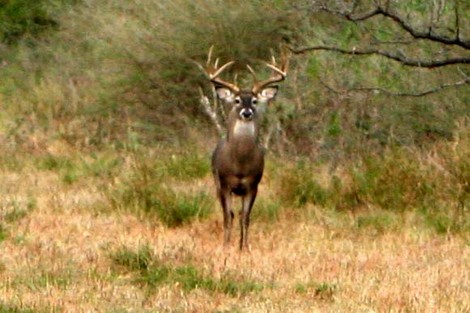
Daylight observations are an ideal way to survey a white-tailed deer herd to determine the herd composition (sex ratios), reproductive success (% fawn crop), and the body condition of deer in a given area. Collecting daylight observations is an easy way to survey the deer herd on your property and data are easy to collect, often incidentally to other activities. Data collected during daylight observations should include sex (buck or doe), age (adult or fawn), and antler quality (number of points, spread, and anything else you can ascertain).
The best time to conduct daylight observation surveys is towards the end of summer and into early fall. In general from mid-August to mid-September is ideal because bucks have identifiable antlers, does are active and moving readily, and the majority of the fawn crop should be old enough to be active, be seen, and be recorded. In addition, this is a great time to collect daylight data because most hunters and land managers are out getting geared up for the upcoming hunting season. All you have to do is work up a data sheet or carry a notepad, carry a trusty set of binoculars and/or a spotting scope, and record animals observed while in the field.
Daylight observations can be collected a variety of ways. I recommend either walking or slowly driving property roads during the first and last two hours of daylight in the early morning or late evening or sitting in areas where white-tailed deer can be readily observed. All daylight observations should be used, but I suggest actively looking for deer in the morning and evening simply because they are more easily observed. Sitting around spin or supplemental feeders enhances the number of deer observations, but make sure to keep an eye out in all directions so that no deer are missed.
Feeders, especially protein feeders, tend to attract bucks and they will dominate the area immediately around feeders because of their aggressiveness and larger body sizes. At this point I will warn you because you are likely thinking that setting up a game camera at a feeder would be an easy way to collect herd composition data. However, because you now know that whitetail bucks dominate feeders — it should be realized that using photos from such areas will make you believe you have a higher percentage of bucks in the deer population than you actually have — so this will not necessarily work, but you can still use them if done properly.
Game cameras can be used, but I recommend using them in conjunction with walking and driving data, as well. If you do use game cameras (and I suggest digital game cameras), I recommend putting them along travel corridors and around water sources. This eliminates much of the bias (more bucks, surveys a smaller area) associated with placing cameras around feeding stations and will give you a better estimating on the percentage of bucks, does, and fawns in your deer herd.
Lastly, the more daylight observations you can collect the more faith you will put into your herd composition estimate. At minimum, you should record at least 75 observations, but a couple hundred would be much better and give you more confidence. Once you’ve collected the data, herd composition is easily calculated:


